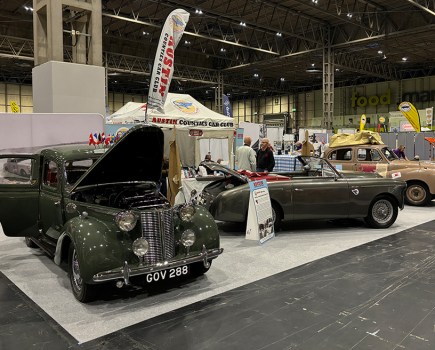The old adage that says ‘all good things come to those who wait’ certainly rings true as prices for well-maintained high-performance prestige sports cars such as the Jaguar XK8 continue to tumble. With the cost of fine examples of these very useable 155mph grand tourers now equalling that of an oh-so-boring secondhand Euro hatch, XK8 ownership – whether a coupé or convertible – has never been more affordable.
Would we recommend putting one of these beauties in the garage to use as an occasional weekend driver before prices start to head north again? You bet your life we would; even though you’ll soon be on first name terms with the local petrol station attendant if you fancy a dash of spirited motoring! However, before discovering why one of these fantastic sporting big cats is so appealing, it’s worth taking a look at the car’s protracted development.
When the wraps came of the XK8 range at the Geneva Motor Show in 1996, the new Jaguar was considered the long-awaited spiritual successor to an iconic sports car unveiled at the same Swiss venue exactly 35 years before – the E-type. The praise lavished on the XK8 at its introduction was, however, in stark contrast to the 1975 launch of the XJS, a controversial design many traditionalists considered to be a world away from the graceful E-type. Although the XJS initially ruffled a few feathers, the V12-powered grand tourer went on to win over many of its detractors by the magnificent way it handled and performed.
Although the XJS matured into a fine car, by the time Ford took control of Jaguar in 1988 the big grand tourer’s days were numbered. Prior to the takeover, Jaguar had invested a huge amount of time and money developing the XJ41 project as a replacement. Even though Jaguar urgently needed a new sports car, this project was scrapped by Ford in the early ‘Nineties and went on to form the basis of the Aston Martin DB7.
Rather than try to squeeze more life out of the XJS, Jaguar’s new masters allocated a budget of £300 million for Project X100 (the XK8) as well as finalising the development of a new Jaguar V8 engine – a huge undertaking on such limited funds. To keep costs under control, the new Jaguar would use a heavily-modified version of the XJS’s floorpan later utilised in the 1994-launched Aston Martin DB7.
UNDER THE BONNET
Although the Jaguar XK8’s all-new all-alloy 4196cc AJ-V8 power unit matched anything produced by the competition when it was launched in 1996, the unit has not been without its problems. Early engines were manufactured without iron cylinder liners and instead had bores plated with 0.008mm (0.003in) of nickel-silicon-carbon (Nikasil) to save weight. Unfortunately this coating led to problems, as the high level of sulphur in ‘Nineties fuel turned to acid during the combustion process and corroded the coating. This led to a serious loss of combustion, the only cure being a new engine and affected all XK8 V8 units to 2000 (VIN 042775).
Jaguar replaced most faulty units under warranty and all post-2000 AJ-V8 engines were fitted with cast iron liners to alleviate the problem. However, if in doubt arrange to have a blow-by test to check the compression in each cylinder – genuine Jaguar replacement engines are painted grey and have a tag attached to the nearside of the block. Timing chain tensioners can also be a problem on early engines as these can break up with disastrous results. Although modified metal tensioners, as fitted to the later 4.2-litre V8, can be retro-fitted to cure the problem, it’s still advisable to investigate any undue noises coming from the front of a Jaguar V8 engine.
Despite the Nikasil and timing chain tensioner problems putting a lot of buyers off older XK8s, the car’s 290bhp V8 engine has proved to be a solid and almost un-burstable unit if serviced correctly. The more powerful supercharged V8 fitted to the XKR coupé and convertible, launched in May 1998, is even more desirable. The XKR’s quad-cam, 32-valve, Eaton-supercharged V8 engine pushes out a very healthy 370bhp, making a pre-2003 4.0-litre example with all its extra standard creature comforts a real bargain – the perfect prestige sports car for the discerning enthusiast.
The XK range was revamped for the 2003-model year, the biggest change being the inclusion of an upgraded 4.2-litre version of the AJ-V8 engine. Power output for the supercharged cars was hiked up to 400bhp at 6100rpm, while the 4.2-litre engine in the naturally aspirated cars boosted power to a very respectable 300bhp at 6000rpm.
ON THE ROAD
Over the years, XK8/XKR auto gearboxes have proved to be reasonably reliable, more so the Mercedes-Benz-derived five-speed ‘boxes fitted to the supercharged and 4.2-litre cars. These ‘boxes have gained a reputation for generally being bulletproof and changes should take place with an appreciable smoothness. Don’t be put off by telephone numbers on an XK8’s odometer. A well cared for example will still look fresh and drive superbly, even with a couple of hundred thousand miles under its designer leather belt. Make sure there’s a fully stamped up service history with the car and that it’s backed up with receipts for all the jobs claimed to have been done.
Handling is excellent and the XK8’s ride reflects its Jaguar pedigree with plenty of grip and ultra-responsive steering. Jaguar engineers put a lot of effort into making the new sports car handle well. This obviously paid off, as a well-sorted XK8 is one of those gorgeous confidence inspiring ‘point and squirt’ sports cars that is guaranteed to provide miles of smiles. The XK8’s finely-tuned rear suspension is a modified version of the X300 saloon’s independent rear set-up, while the front suspension is formed around a large die-cast aluminium front axle beam. Although the front beam is a sturdy affair, Jaguar specialist Jagutek (01353 667147) has seen an increasing number of XK8s with corrosion where the beam attaches to the innerwings, an issue often missed by MoT inspectors unfamiliar with the car.
An XK8’s interior is a great place to be and should be in good order throughout. The huge chunk of rainforest decorating the dashboard needs to be devoid of scratches or unwanted mobile phone cradles. Likewise with the leather seat facings, these should all be in perfect order, with just a slight amount of creasing on the driver’s seat. Scruffy interiors not only let a car of this pedigree down, they are very expensive to repair and are best avoided.
Jaguar also produced a number of limited editions before the XK8 was superseded by a brand-new aluminium-bodied replacement in 2005. First of these now very sought after specials was the XKR Silverstone, launched to celebrate Jaguar’s entry into Formula One in 2000. A total of 563 were built, although only 107 remained in the UK. These can be identified by their silver paint, special badges and tread plates, 20-inch wheels and feature uprated transmission, brakes, steering and suspension.
In 2002, Jaguar launched what has become probably one of the most sought after special Jaguar sports editions – the XKR 100 to celebrate the centenary of the birth of William Lyons. Only 500 coupés and 500 convertibles were built and featured a special anthracite paint finish, black leather interior, Brembo brakes and 20-inch BBS wheels. Limited edition Jaguar XKR 100s are identified by revised bonnet badges, special chequered-flag decorated tread-plates, 19-inch Atlas wheels and bright red Brembo brake callipers. The magnificent XKR 4.2-S was unveiled at the Geneva Motor Show in 2005 and was the last XK to be based on the 1996-launched design.
VERDICT
A well cared for XK8 or XKR in either Classic or Sport trim makes perfect sense for anyone seeking a fast, well-mannered sports car with an outstanding pedigree. They’re great to look at and are also outstanding value at the moment.
Fine examples of these beautifully-crafted cars are set to mature into desirable classics very quickly so if you’ve got the cash and the space, buy a dozen as an investment and store them away for the future – it’s better than leaving the money in the bank! The car’s fuel economy issues aside, finding a more interesting prestige grand tourer for a sub-ten grand budget would be a very hard task indeed.
Mechanically, XK8s are reasonably bulletproof providing the timing chain issue has been sorted out, although early water pumps with plastic impellors can break up and should be changed for metal ones. Rattles at the rear indicate the shock absorbers are on the way out – expensive if the car is fitted with optional CAT active suspension.







